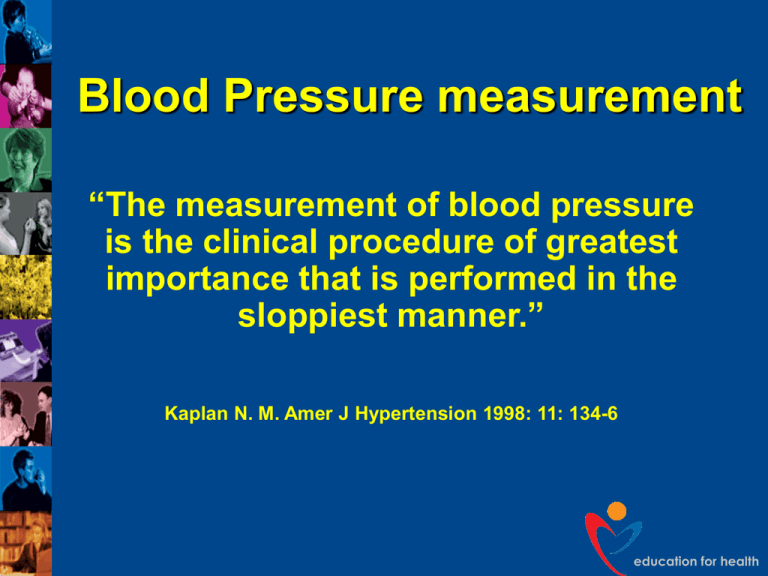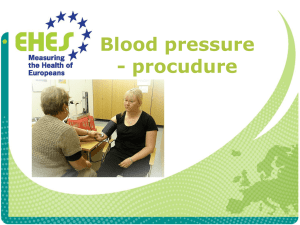Blood pressure measurement
advertisement

Blood Pressure measurement “The measurement of blood pressure is the clinical procedure of greatest importance that is performed in the sloppiest manner.” Kaplan N. M. Amer J Hypertension 1998: 11: 134-6 education for health The ‘silent killer’ Causes death from: Strokes Heart Attacks Peripheral Vascular Disease If untreated, leads to: Renal failure, heart failure education for health Blood Pressure classification Category Systolic BP Diastolic BP Optimal <120 <80 High normal BP <130 <85 High normal BP 130-139 85-89 Grade 1 (mild) 140-150 90-99 Grade 2 (moderate) 160-179 100-109 ≥180 ≥110 ISH (Grade 1) 140-159 <90 ISH (Grade 2) ≥160 <90 Grade 3 (severe) education for health Thresholds for intervention BP ≥ 220/120 mmHg: treat immediately BP >180-189/110/119 mmHg: confirm over 1-2 weeks, then treat BP 160-179/100-109 mmHg: with CVD complications: confirm over 3-4 weeks, then treat BP 140-159/90-99 mmHg: with CVD risk confirm over 12 weeks, then treat. education for health Blood pressure measurement sources of error Errors due to manometer Errors due to cuff Errors due to the observer Errors due to the patient. education for health Which machine? Every practice/ward should be using a validated manometer All manometers should be recalibrated and serviced annually Aneroid machines (not recommended) should be serviced more often as they deteriorate rapidly Useful website:- www.bhsoc.org education for health education for health Manometers – electronic advantages You can effortlessly take several readings Meanwhile you can check pt records Some ‘whitecoat’ effect can be detected You can rely on the readings of other health care professionals. (These advantages partly outweigh the disadvantage of the possible, slight inaccuracy of some devices). education for health Manometers – automatic disadvantages Inadequate choice of cuff sizes Large cuffs are long enough but too deep Need for the equivalent of the ‘alternative adult cuff’ only available with the mercury manometer. education for health BP measurement Three or more readings, separated by 1 minute Discard first reading and average last two If large difference take further readings. education for health BP measurement -cuffs Cuff too small or too big Normal cuff too small for 15% of patients Cuff not level with the heart Leaky rubber tubing or bladder* Faulty inflation/deflation device* * Applies to mercury manometers only. education for health Cuff sizes Type Size Suitability Adult 12cm by 23cm for smaller arms Alternative cuff 12cm by 36cm will cover 95% arms 15cm by 36cm Often too wide for ‘fat’ arms Large adult education for health Which arm? 6% of hypertensives can have as much as a 10 mmHg difference between arms If BP higher in one arm than the other, this arm must be used from then on Document this in records so that everyone uses the same arm. education for health Technique Patient seated and relaxed, not talking, legs uncrossed Tight arm clothing removed Correct cuff size Arm supported with cuff horizontal with heart Inform patient of discomfort and that several measurements will be taken Mercury manometer on firm and level surface at eye level Locate brachial or radial pulse. education for health Technique – cont’d Place stethoscope gently over brachial artery Inflate mercury rapidly, 30 mmHg above occlusion of pulse Deflate very slowly, 2 mmHg per second Record first of regular sounds (systolic BP) Record diastolic as disappearance of sound Record measurements to the nearest 2 mmHg Repeat twice more and average last two. education for health BP measurement - observer Mercury column not level with the eyes Failure to hear the Korotkoff sounds Wrong diastolic endpoint (K4 or K5) Subjective detection of Korotkoff sounds Rapid cuff deflation Single one off reading. education for health Stethoscope ‘I have never managed to communicate to any patient, that there is really no point in trying to talk to me when I am using a stethoscope’. Gardiner – Hospital Doctor - 1993 education for health Stethoscope Good quality Short tubing Well fitting ear pieces (cleaned regularly) Place gently over the brachial artery Avoid touching the cuff and tubing. education for health Posture Routine - seated Standing in patients with symptoms or diabetic (diabetic nephropathy) and the elderly Supine position unnecessary, inconvenient and cuff position often below the heart. education for health BP measurement - patient Anxiety and unfamiliarity Animated discussion about the latest news Ambient temperature Full bladder! Postural hypotension Difference between arms. education for health Patient Consent is taken as read when patient rolls up sleeve Explain the procedure, that it may be a little uncomfortable and that several readings will be taken Seated, relaxed, not speaking Tight arm clothing removed Arm supported (not hyper extended) with cuff level with the heart. education for health Explanation to the patient Tell the patient their blood pressure reading Write BP down – use co-operation cards Give relevant leaflets/booklets on life style issues (not too many at a time) Reassure patient that this is a risk factor not a disease (unless left untreated) Do not lose to follow-up. education for health ‘White coat’ hypertension Effective method of diagnosing a rise in blood pressure associated with having blood pressure measured Maybe from anxiety 10-20% of subjects labelled ‘hypertensive’ may have ‘white coat’ effect. education for health Ambulatory blood pressure measurement (ABPM)- indications Borderline hypertension White coat hypertension Isolated systolic hypertension Nocturnal blood pressure Resistant hypertension Hypotensive symptoms. education for health ABPM Can be expensive Should be comfortable for patient to wear (light and quiet) Use of correct cuff size Need to be familiar with equipment Time to instruct patient, full explanation to patient of what is required Requires patient co-operation in order to obtain as many readings as possible. education for health ABPM cont …. Normal activity to be maintained, except when measurements are being made Subject’s arm to be still during measurement Subject’s usual activities to be carried out Working days not compared to recreational days For clinical use recordings are usually programmed for every 30 minutes during the day and hourly at night Subject required to keep a diary of activities and symptoms. education for health Home monitoring Gives patients empowerment May improve medication concordance Device used must be validated Multiple day time recordings, over 7 days (eliminating ‘white coat’ effect) with BP taken in the morning and evening First 24 hour readings should be discarded Home measurements usually lower than clinic readings. education for health











